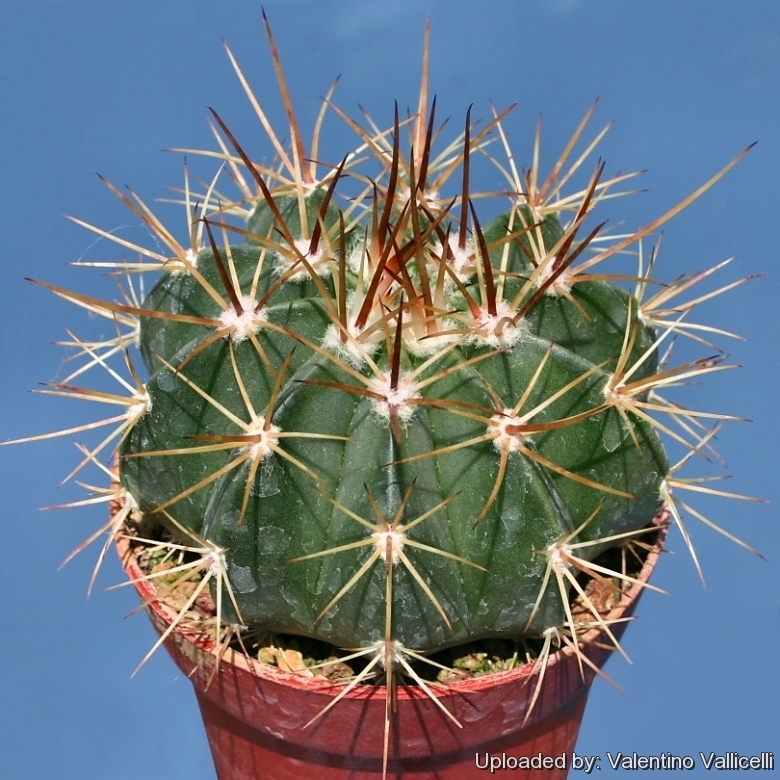Accepted Scientific Name: Melocactus bahiensis subs. amethystinus (Buining & Bredero) N.P.Taylor
Bradleya 9: 30 1991

Melocactus grisoleoviridis Photo by: Valentino Vallicelli
Origin and Habitat: Itamarandiba, Northern Minas Gerais, Brazil.
Altitude: Around 850 metres above sea level.
Synonyms:
See all synonyms of Melocactus bahiensis
Common Names include:
PORTUGUESE (Português): Cabeca de Frade, Coroa de frade
Description: Melocactus grisoleoviridisSN|2283]]SN|2293]] distinguishes from the standard Melocactus bahiensisSN|2293]]SN|2283]] subs. amethystinus for its larger green till silver body. It has also a taller cephalium with wool and brown bristles. It remembers a crowned head. Plants of this genus attract more attention in collections than those of any other cactus genera.
Stem: Depressed-spherical, globose or pyramidal, light to dark green 10-21 cm tall, 11-21 cm in diameter in diameter.
Ribs: 10-12 acute and variable in shape.
Areoles: White 10-24 mm apart.
Cephalium: Mostly small with many brown bristles up to 5 cm high and 6,5-8,5 cm in diameter.
Spines: Short, curved, off-white, except in the centre where the new ones are yellow, reddish brown, dark brown to black often bent or even hooked in juvenile specimens.
Central spines: 1-4 per areola, 10-53 mm long mostly straight-projecting:
Radial spines: 7-12 mostly straight. 13-50 mm long, the lowermost only a little longer than the others.
Flowers: 18-23 mm long, 10-12 mm wide.
Fruit: Berry, club-shaped up to 25 mm long, 9 mm in diameter, red to crimson on the top, white or pale pink at the base.
Seeds: 1-1,35 x 1 mm somewhat tuberculate.
Subspecies, varieties, forms and cultivars of plants belonging to the Melocactus bahiensis group
- Melocactus bahiensis (Britton & Rose): (subsp. bahiensis) has several local form with both acute or rounded ribs. Distibution: more northern part of eastern Brazil.
- Melocactus bahiensis subs. amethystinus (Buining & Bredero) N.P.Taylor: has more acute ribs that are triangular in cross section. Distribution: southern part of Bahia and northern Minas Gerais.
 Melocactus grisoleoviridis Buining & Bredero: large plants with green till silver body, taller cephalium. Distribution: Itamarandiba,. Minas Gerais.
Melocactus grisoleoviridis Buining & Bredero: large plants with green till silver body, taller cephalium. Distribution: Itamarandiba,. Minas Gerais.
Bibliography: Major references and further lectures
1) David Yetman “The Great Cacti: Ethnobotany & Biogeography” University of Arizona Press, 2007
2) Stuart Max Walters “The European garden flora. 3.[Angiospermae], Dicotyledons. [Casuarinaceae to Aristolochiaceae]” Cambridge University Press, 1989
3) Edward Anderson “The Cactus family” Timber Press, Incorporated, 2001
4) James Cullen, Sabina G. Knees, H. Suzanne Cubey "The European Garden Flora Flowering Plants: A Manual for the Identification of Plants Cultivated in Europe, Both Out-of-Doors and Under Glass" Cambridge University Press, 11/Aug/2011
5) David R Hunt; Nigel P Taylor; Graham Charles; International Cactaceae Systematics Group. "The New Cactus Lexicon" dh books, 2006
6) Taylor, N. P. “The genus Melocactus (Cactaceae) in Central and South America.” Bradleya 9: 1–80 1991
7) Urs Eggli, Leonard E. Newton “Etymological Dictionary of Succulent Plant Names” Springer, Berlin/Heidelberg 2010
8) N. L. Britton, J. N. Rose “The Cactaceae. Descriptions and Illustrations of Plants of the Cactus Family.” Volume III, The Carnegie Institution of Washington, Washington 1922
9) Philipp von Luetzelburg “Estudo Botanico do Nordéste.” Volume 3, 1923
Cultivation and Propagation: These tropical cacti are not the easiest things to grow and aren’t plants for beginners.
Growth rate: It is a relatively rapidly growing given the best conditions.
Soils: It likes very porous standard cactus mix soil.
Repotting: The root system is weak and generally resents being repotted and can take a long time to re-establish. Use pot with good drainage.
Light: They prefer very bright light, not as much as the most arid growing cacti, but plenty nonetheless. Tends to bronze in strong light, which encourages flowering and heavy spine production.
Watering: Melocacti grow from April to October and cannot endure long stretches of total dryness, and also too much water will rot them, as their weak root systems tends to be inefficient at sucking up water from wet soil. Nonetheless, again as a result of their tropical origins, they need a fair amount of water, but allow the soil to dry quite a bit before watering again.
Fertilization: Do not feed in winter.
Hardiness: Melocactus rest from October to April but can’t stand cold, or even fairly cool temperatures, so is indispensable to keep them above 8-12°C at all times, severe damage or death occurring at temperatures that the great majority of cacti wouldn’t mind in the least and prefer more frequent water in winter than other cacti, say once a month. (but hardy to 4 C ° C for short periods). However warmth throughout the year will increase the grower's success (minimum 12° to 20° C during rest season).
Pests & diseases: It may be attractive to a variety of insects, but plants in good condition should be nearly pest-free, particularly if they are grown in a mineral potting-mix, with good exposure and ventilation. Nonetheless, there are several pests to watch for:
- Red spiders: Red spiders may be effectively rubbed up by misting the vulnerable plants every day
- Mealy bugs: Mealy bugs occasionally they develop aerial into the new growth among the wool with disfiguring results, but the worst types develop underground on the roots and are invisible except by their effects.
- Scales: Scales are rarely a problem.
- Rot: it is only a minor problem with cacti if the plants are watered and “aired” correctly. If they are not, fungicides won't help all that much.
Propagation: Exclusively by Seeds. Sow in February-march in a light, sandy, porous soil. Cover germinating tray with glass to prevent seed from drying out. Germination is most successful at a temperature of 18 to 22° C.










